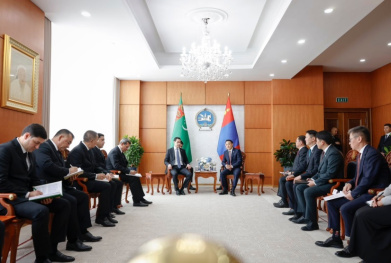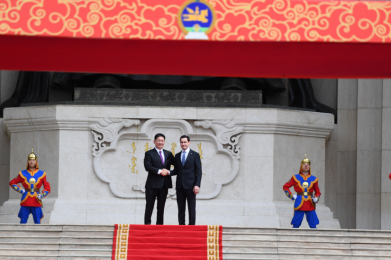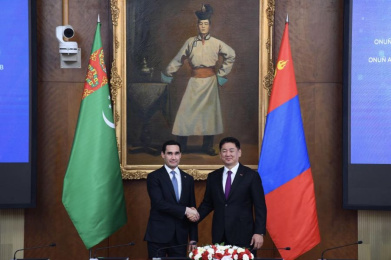A visit that shapes the new architecture of the Turkmen-Mongolian dialogue
02.06.2025 | 21:05 |Ulaanbaatar, June 2 | ORIENT. Today, a significant step was taken towards comprehensive cooperation between the two nations, whose historical ties date back to ancient times (see Rashid ad-Din. Collection of Chronicles).
As part of the state visit, key negotiations were held between President of Turkmenistan Serdar Berdimuhamedov and the leadership of Mongolia. These meetings not only continued the progressive strengthening of bilateral relations, but also marked a new stage in the development of strategic partnership.
The special status of the visit – a state one – testifies to the high level of trust and political significance of the dialogue. A state visit is the highest form of diplomatic contacts, and its choice underscores the intention of the parties to give the relations not only symbolic, but also substantive depth.
During the visit, which took place on the invitation of President of Mongolia Ukhnaagiin Khurelsukh, mutual readiness to strengthen cooperation in a wide range of areas was confirmed - from political, diplomatic and economic interaction to science, education and culture.
In addition to what was said, we recall: the President of Turkmenistan noted that the accumulated experience and mutual interest of the parties create a solid foundation for the implementation of mutually beneficial initiatives.
During the meetings, words of gratitude were expressed to Chairman of the Khalk Maslakhaty Gurbanguly Berdimuhamedov, from whom warm greetings were conveyed.
Separately, the importance of the visit of the head of Mongolia to Turkmenistan in October 2024 and his participation in the celebrations dedicated to the 300th anniversary of the great poet and thinker Magtymguly Fragi - a symbol of the spiritual kinship of the two peoples was emphasized.
A key element of the program was the meeting between Serdar Berdimuhamedov and the head of the national parliament, Chairman of the State Great Khural Dashzegviin Amarbayasgalan.
The speaker of parliament highly praised the peaceful and constructive foreign policy of Turkmenistan and expressed confidence that inter-parliamentary relations will also receive additional development against the backdrop of strengthening dialogue at the highest level.
The visit resulted in the signing of an impressive package of documents - about fifteen agreements covering strategic, economic and humanitarian spheres.
The very scale and thematic breadth of the documents - from interstate to inter-museum - reflect the integrity and thoughtfulness of the approach to forming the bilateral agenda.
If you pay attention to the key points of the documents, the comprehensive approach to their selection immediately catches your eye.
Thus, the establishment of the Joint Commission, the approval of the Cooperation Programs between the Ministries of Foreign Affairs and the signing of the Joint Statement set a stable framework for regular political and practical interaction.
The applied economic aspect is indicated by the attention of both parties to the development of trade, small and medium-sized businesses, logistics, agriculture and processing of products. A number of documents in this group demonstrate a focus on tangible economic returns from partnership.
A wide block of agreements in the field of education, science, healthcare, mass media, museums and academic exchanges emphasizes the role of "soft power" and creates an environment of sustainable mutual understanding. And this is where the humanitarian richness of the negotiation process is especially felt.
Memorandums between universities, research institutions and cities take the partnership beyond the protocol framework, creating a basis for public diplomacy and a lively exchange of initiatives, forming so-called "horizontal" ties.
Even a quick glance at the signed documents confirms the systematic approach of both parties to the further development of the partnership.
As a result, the conclusion suggests itself that the State visit of the President of Turkmenistan to Mongolia was not just evidence of the high level of bilateral relations, but also an event that opened a new chapter in their development.
The signed documents form a strategic roadmap for the years to come, ensuring both political and diplomatic rapprochement and the practical implementation of common interests.
Historical closeness, mutual respect and coincidence of priorities create a solid platform for further deepening of the partnership.
Today's dialogue is not just an exchange of protocol statements, but evidence of the maturity of relations, readiness for a joint future and mutual growth.
It would not be in vain to add that entrepreneurs from both countries organized a business forum, establishing direct contacts and laying the foundation for long-term cooperation in the areas of food, agriculture, textiles and knitwear.
And the visit ended with a joint concert, in which more than 80 artists from Mongolia and Turkmenistan took part, performing at the Academic Opera and Ballet Theater.
And now, instead of a conclusion and for the sake of completeness of the picture of the effectiveness of the negotiation process, we will provide a brief overview with an assessment of the content of the signed documents and their practical focus. So:
1. The Joint Statement records the political will of the parties to develop a strategic partnership, emphasizing the priority of mutual interests in politics, economics, logistics and the humanitarian sphere;
2. The Agreement on the Establishment of a Joint Commission ensures regular consultations and coordination of actions in areas such as trade, science, agriculture and education;
3. The General Agreement on Economic Cooperation sets out mechanisms for coordinating projects, exchanging experience and developing business ties;
4. The Medium-Term Economic Cooperation Program (2026–2028) specifies steps for the next three years to increase trade turnover, support small and medium-sized businesses, investments and infrastructure development;
5. The Cooperation Programme between the Foreign Ministries (2026–2027) strengthens foreign policy coordination and provides for regular exchange of information over the next two years;
6. The Memorandum on Light Industry opens up opportunities for technological cooperation, especially in the textile industry;
7. The Agreement in the field of Education creates conditions for academic exchanges, mutual recognition of diplomas and joint research;
8. The Agreement between the Capitals of Ulaanbaatar and Ashgabat activates city diplomacy and joint urban initiatives;
9. The Memorandum between the Academies of Sciences lays a scientific platform for joint research and exchange of research experience;
10. The Agreement between National Museums focuses on the preservation of cultural heritage and advanced training of cultural specialists;
11. The Agreement in the field of Television and Radio Broadcasting promotes the formation of an information bridge and the development of joint media content;
12. The Memorandum between National Universities promotes academic and medical partnership, including scientific research;
13. The Agreement in the field of Public Administration and International Relations is focused on training personnel and joint projects on international topics;
14. Cooperation between News Agencies enhances the exchange of news and forms the basis for professional media contacts.
So, we have every reason to say that thanks to the visit of President Serdar Berdimuhamedov to Ulaanbaatar, a new architecture of Turkmen-Mongolian cooperation is beginning to take shape.
Бекдурды АМАНСАРЫЕВ











